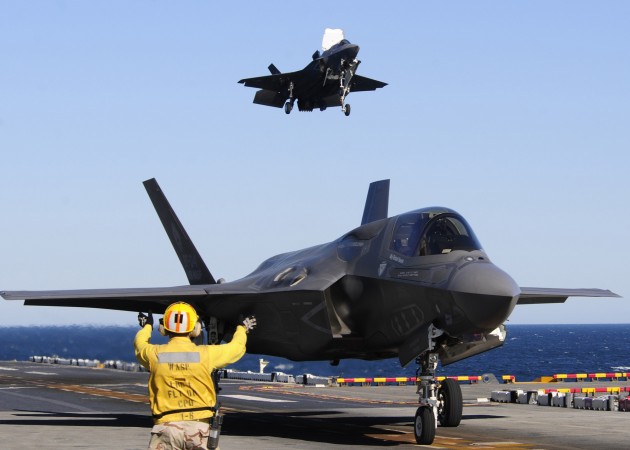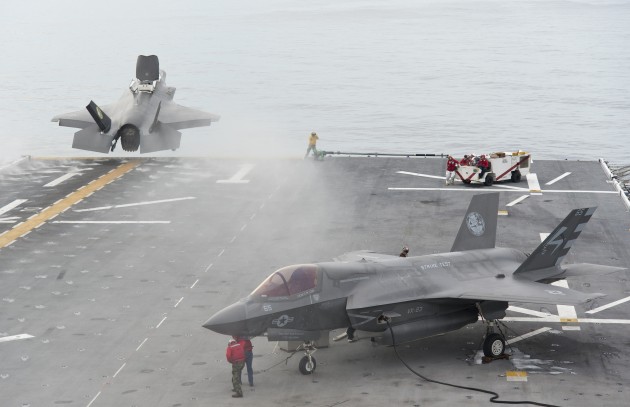 USS WASP: The Marines and Navy have spent most of the last three weeks putting the new F-35B through its paces here, executing more than 90 short takeoffs and vertical landings, including 19 at night.
USS WASP: The Marines and Navy have spent most of the last three weeks putting the new F-35B through its paces here, executing more than 90 short takeoffs and vertical landings, including 19 at night.
More than 1,200 Marine test pilots, engineers, experts from the Joint Program Office running the program and Navy and industry civilians are collecting enormous amounts of data from the two aircraft, BF-1 and BF-5, and the ship itself to ensure the planes are performing as they should. The Marine version of the Joint Strike Fighter is designed to take off from smaller aircraft carriers, some other Navy ships, roads and land bases. It can land vertically and usually does a short take off.
I headed out to the Wasp yesterday morning with a small group of journalists on V-22s, Marine aircraft capable of taking off and hovering like a helicopter and flying like a plane. Ironically, both JSF planes had glitches while we were out on the ship, though BF-1 began flying again soon after we left. The second plane appeared to have a “pretty significant problem,” a crew member told me. Its Integrated Power Package, a sort of super generator that powers many of the plane’s sophisticated electronics would not start. I’ve emailed the Joint Program Office for an update and will update this as soon as we hear from them.
One of the biggest concerns about the F-35B, which directs most of the engine’s power directly down to the ship’s deck as it lands, was that it would damage the ship’s deck so much at each landing that the Wasp and other ships — or the F-35B — would have to be redesigned to mitigate that problem. I spoke with several deck crew, the men and women who wear yellow shirts on the carrier deck and execute the dangerous ballet of launching and retrieving aircraft from the Wasp. They say that, after taking off and landing several times almost every day since Aug. 12, they are seeing less damage to the deck than it sustains from some other aircraft that routinely fly from the Wasp and other LHD class ships.
The Navy and Marines have added a new coating to the deck where F-35Bs land, called Thermion. From all accounts, it’s a remarkable product composed of aluminum and ceramic bonded together by heat at application to form a very smooth and tough heat-resistant coating.
There is one part of the ship that is sustaining unanticipated — if not critical — damage, namely the edge of the bow. Nets to catch crew members who might lose their footing in rough seas or be blown down by a passing aircraft are being severely rattled by the enormous downwash from the F-35B’s jet engine as it passes low over the end of the ship. The wire netting is snapping and some of the structure that supports the nets is being bent. And lights just under the deck’s lip are being shattered.
Chief Steven Vlasich, who is responsible for maintaining the deck, took me up to check the damage. I leaned over the bow, saw a few snapped wires. It didn’t look too bad, but then Vlasich and his crew had been fixing everything they could. The chief and three other yellow shirts told me the Thermion appeared to be working well. But Vlasich said he’d like to keep much of the deck covered with its current aluminum product, which is much rougher than Thermion. He thinks it gives crew members better traction, especially when the deck is wet and covered in leaking hydraulic fluid and oil.
Joe Spitz, a systems engineer with Naval Sea Systems Command, told me they’ve got several solutions they’re considering for the nets. One would be pretty simple: drop them down as the jets take off.
He doesn’t agree with Vlasich about Thermion. He says it is safer than the older surface and grips better. Perhaps most important, you can clean oil and other fluid from it more effectively, Spitz says. The Wasp is reportedly going to have its entire deck coated in Thermion.
But these are secondary, if important issues. What really matters to those on the Wasp is that they are getting the F-35B into the air consistently and safely.
If you want to get some idea of just how much this means to the Marines, note the applause by crew lined up on Vultures Row as the F-35B lands on the deck in the video above.
To give you an idea of how well run this ship looked to be run, the captain kindly let us eat in the officer’s mess (we all paid our $5) and we were treated on Slider Wednesday to some of the tastiest cheeseburgers and freshest condiments any of the press corps could remember. The Army may march on its stomach, but the Navy may be sailing past them.
Navy jet trainer fleet operations remain paused after engine mishap
One week after the incident, a Navy spokesperson says the service is continuing to assess the fleet’s ability to safely resume flight.




























